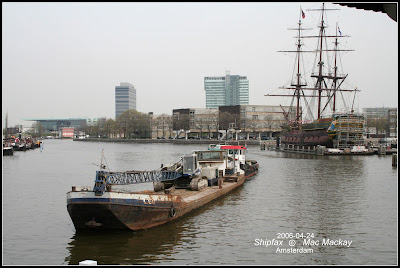The new RTG (numbered 76, and built by Konecranes) was soon being tested and may be in service virtually immediately. It has several features, including active load control and pre-programmed drive path, that will allow Halterm to increase its storage capacity by up to 40% according to publicity material from Konecranes.
Today's weather precluded any decent photos of the unloading operation, and only the following photo of the ship as it sailed.
Spliethoff ships are each named "...gracht", after one of the many grachten or canals of Amsterdam. In the case of the Schippersgracht it is named for a canal where many ships's captains (schippers) once lived . It is a very short (only 100 meters long) but busy gracht - at least on the day that I visited in 2006.
To reach the schippersgract, vessels come from the River Ij into the Oosterdok, past the Amsterdam Maritime History Museum.
A bridge (the Kortjewandtsbrug) carrying the busy four lane Hendrikkade opens to allow vessels to enter the Skippersgracht itself. In typical Dutch fashion, the bridge master arrived by bicycle and entered the black tower on the right to operate the bridge.
...but eases over to allow a canaller to clear the bridge.
Schippersgracht is also the name of the street on the northwest side of the canal (on the left) , that contains many heritage buildings. The new building in the left background is the city's Architecture and Urban Design exhibition centre called Arcam.
Once in the canal it is hardly any distance at all before the quaint bridge of the Kadijksplein, called the Scharrebiersluis (which normally would mean lock) opens to allow access to the Rapenburgerschut Lock (sluis 110) measuring 72m x 8.76m.
Only the lock gate at the south end (out of sight) operates, giving access to the Nieuwe Herengracht. With the bridge closed pedestrian and vehicle traffic resumed.
Once through the Schippersgracht vessels reach the Nieuwe Herengracht linking to the scores of other canals that form arcs and radii around Amsterdam, much like a maze. Standardization of bridge clearances and lock sizes allows for many classes of vessels to use the canal system and it is still a primary source of commercial transport within the old city, where roads are often to narrow for trucks.
Not among those vessels is the Schippersgracht itself - it is too large to fit into its gracht namesake.
.










No comments:
Post a Comment